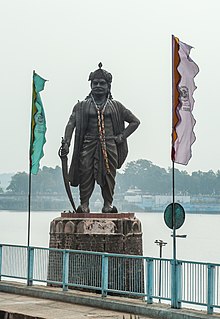| Bhoja | |||||
|---|---|---|---|---|---|
| Parama-bhattaraka Maharajadhiraja Parameshvara | |||||
 Statue of Raja Bhoja in Bhopal | |||||
| King of Malwa | |||||
| Reign | c. 1010–1055 CE | ||||
| Predecessor | Sindhuraja | ||||
| Successor | Jayasimha I | ||||
| Spouse |
| ||||
| Issue | Probably Jayasimha I | ||||
| |||||
| Dynasty | Paramara | ||||
| Father | Sindhuraja | ||||
| Mother | Savitri (according to Bhoja-Prabandha) | ||||
| Religion | Hinduism | ||||
| Royal sign-manual | |||||
Bhoja | |
|---|---|
| Battles / wars | Military career of Bhoja |
Bhoja was King of Malwa from 1010 until his death in 1055. Bhoja fought wars with nearly all his neighbours in attempts to extend his kingdom, with varying degrees of success. At its zenith, his empire extended from Chittor in the north to upper Konkan in the south, and from the Sabarmati River in the west to Vidisha in the east.
Because of his patronage to scholars, Bhoja became one of the most celebrated kings in the Indian history. After his death, he came to be featured in several legends as a righteous scholar-king. The body of legends clustered around him is comparable to that of the Emperor Vikramaditya.
Bhoja is best known as a patron of arts, literature, and sciences. The establishment of the Bhoj Shala, a centre for Sanskrit studies, is attributed to him. He was a polymath, and several books covering a wide range of topics are attributed to him. He is also said to have constructed a large number of Shiva temples, although Bhojeshwar Temple in Bhojpur (a city founded by him) is the only surviving temple that can be ascribed to him with certainty.